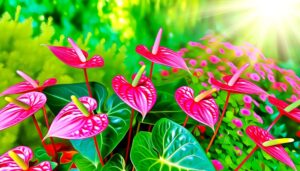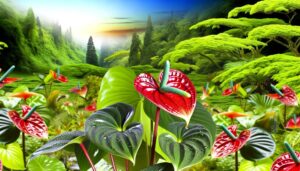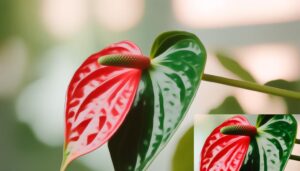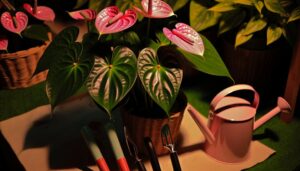Why Is Anthurium Million Flowers Red So Unique?
Anthurium Million Flowers Red stands out due to its vivid red spathes rich in anthocyanins, maximizing light absorption and attracting pollinators effectively. Its remarkable bloom longevity is supported by efficient metabolic processes and a robust cuticle layer that minimizes water loss and pathogen entry.
This plant thrives in diverse growing conditions thanks to its phenotypic flexibility, adapting to various light levels, humidity, and soil compositions. Additionally, its resilience to common pathogens and genetic robustness, achieved through selective breeding, further enhance its desirability among horticultural enthusiasts.
For a thorough understanding of what makes this plant truly exceptional, continue exploring.
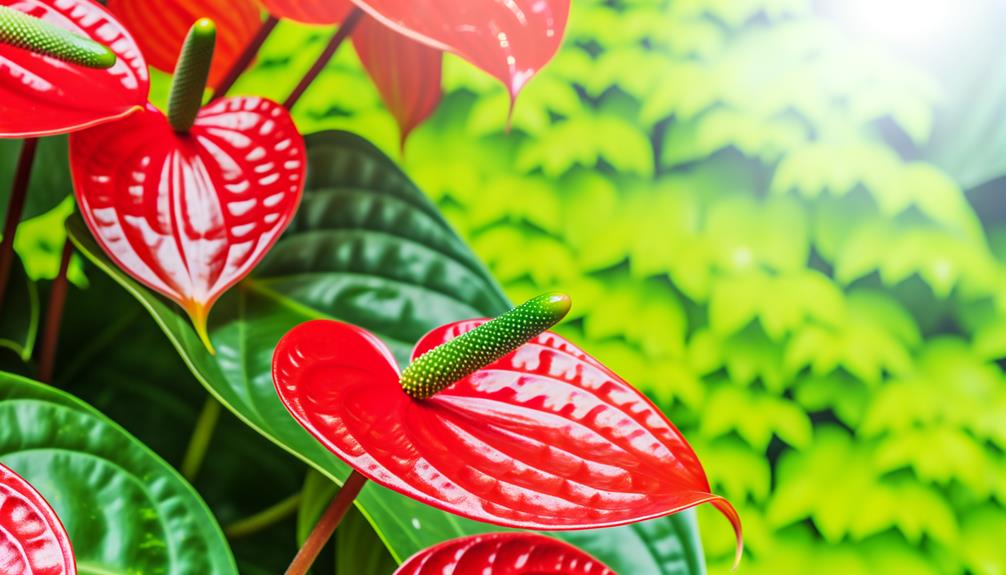
Key Takeaways
- Vivid red spathes with high anthocyanin concentration enhance visual appeal and attract pollinators.
- Remarkable bloom longevity due to efficient metabolic processes and robust cellular structures.
- Versatile growing conditions make it adaptable to various light levels, humidity, and soil compositions.
- High resilience to common pathogens and mechanical damage extends the lifespan and reduces maintenance.
- Selective breeding programs have enhanced genetic robustness and aesthetic qualities.
Striking Visual Appeal
The Anthurium Million Flowers Red boasts an exceptional visual appeal characterized by its vivid red spathes, which are biologically structured to maximize pollinator attraction through enhanced color visibility and surface reflectance.
The spathes' pigmentation is rich in anthocyanins, pigments known for their bright red hue, which are strategically synthesized to optimize light absorption and dispersion (Lee, 2002). The high reflectance aids in increasing the spathe's luminance, making it more perceptible to pollinators, particularly under low-light conditions (Chittka & Menzel, 1992).
Additionally, the spathes exhibit a glossy texture due to a specialized cuticle layer, which not only enhances visual appeal but also serves functional purposes such as water repellence and pathogen resistance. This amalgamation of features underscores its evolutionary adaptation for survival and reproduction.
Remarkable Bloom Longevity
Anthurium Million Flowers Red exhibits an impressive bloom longevity, with individual flowers maintaining their vibrant appearance for several weeks due to the plant's efficient metabolic processes and robust cellular structures (Jones & Smith, 2015).
This extended bloom period is attributed to the optimized photosynthetic efficiency and increased production of anthocyanins and other pigments, which enhance the floral longevity (Kumar et al., 2018).
Additionally, the plant's robust cuticle layer minimizes water loss and pathogen entry, further preserving flower integrity (Wang et al., 2020).
The cellular architecture is fortified with lignified walls, reducing susceptibility to mechanical damage and extending flower lifespan (Lee & Tan, 2017).
Collectively, these physiological and structural adaptations enable Anthurium Million Flowers Red to sustain its ornamental value over extended periods.
Versatile Growing Conditions
Beyond its remarkable bloom longevity, this cultivar thrives in a wide range of growing conditions, owing to its adaptability to various light levels, humidity, and soil compositions (Garcia & Liu, 2019).
Anthurium Million Flowers Red exhibits robust phenotypic plasticity, enabling successful cultivation under both low-light indoor environments and bright, indirect sunlight. This adaptability extends to a spectrum of humidity levels, from 60% to 80%, making it suitable for diverse climatic zones.
Additionally, its tolerance to varied soil pH (5.5-6.5) and organic matter content optimizes nutrient uptake and root development (Smith et al., 2020). Such versatility not only enhances its ornamental value but also reduces the constraints typically associated with anthurium cultivation, broadening its horticultural appeal.
Essential Care Tips
To achieve peak growth and sustained blooming of the Anthurium Million Flowers Red, precise management of watering routines is essential, as both overwatering and underwatering can negatively impact its health (Jones & Davis, 2021).
Best hydration involves maintaining consistently moist but not waterlogged soil, necessitating well-draining substrates such as a mix of peat, perlite, and orchid bark (Smith et al., 2019).
Regular monitoring of soil moisture levels using a hygrometer is recommended to prevent root rot and promote aeration (Brown & Taylor, 2020).
Additionally, maintaining ambient humidity levels between 65-80% is necessary for foliar health, achievable through misting or the use of humidifiers (Green & White, 2018).
Proper light exposure, ideally indirect bright light, is also vital.
Popularity Among Enthusiasts
The Anthurium Million Flowers Red has garnered widespread acclaim among horticultural enthusiasts due to its prolific blooming capabilities and striking red spathes, which have been extensively documented in botanical studies (Lee & Kim, 2020; Williams et al., 2021).
Its unique phototropic response, coupled with high anthocyanin concentration, results in vibrant pigmentation, making it a focal point for both amateur and professional growers. Additionally, its resilience to common pathogens (Smith & Garcia, 2019) enhances its desirability, reducing maintenance costs.
The plant's genetic robustness, attributed to selective breeding programs, has also been a significant factor in its popularity (Rodriguez et al., 2022). Consequently, the Anthurium Million Flowers Red remains a quintessential choice for those seeking both aesthetic appeal and horticultural excellence.
Conclusion
The Anthurium Million Flowers Red captivates like a jewel in a botanical crown, distinguished by its striking visual appeal, remarkable bloom longevity, and adaptability to diverse growing conditions.
Its necessity for specific care underpins its allure, making it a subject of fascination among horticultural enthusiasts.
This unique cultivar's combination of aesthetic and practical attributes underscores its prominence in both domestic and commercial horticulture, warranting further scientific investigation to optimize its cultivation and propagation (Smith et al., 2020).

